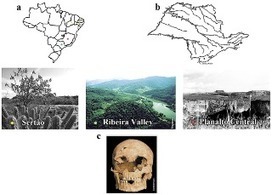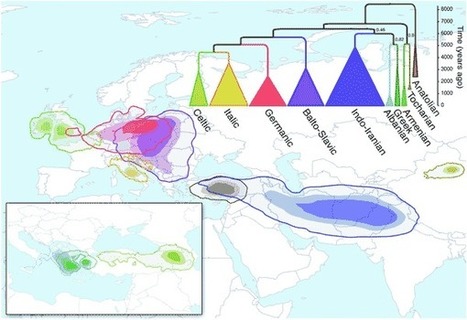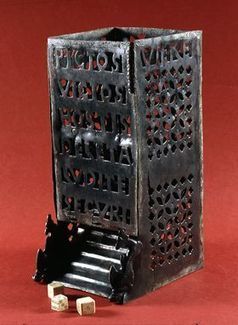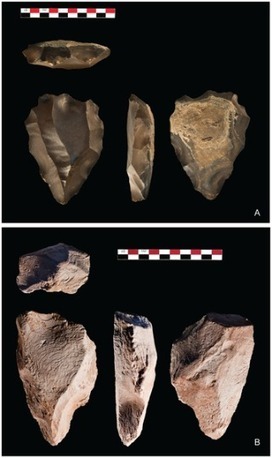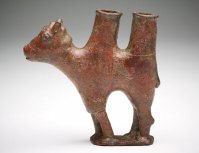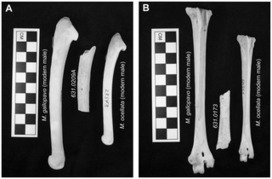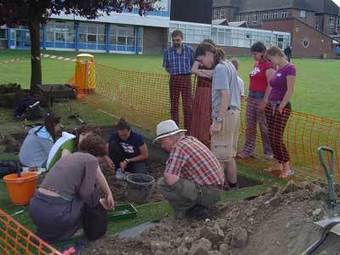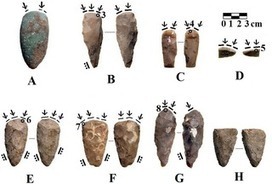 Your new post is loading...
 Your new post is loading...

|
Scooped by
David Connolly
August 27, 2012 3:26 PM
|
During the early Holocene two main paleoamerican cultures thrived in Brazil: the Tradição Nordeste in the semi-desertic Sertão and the Tradição Itaparica in the high plains of the Planalto Central. Here we report on paleodietary singals of a Paleoamerican found in a third Brazilian ecological setting – a riverine shellmound, or sambaqui, located in the Atlantic forest. Most sambaquis are found along the coast. The peoples associated with them subsisted on marine resources. We are reporting a different situation from the oldest recorded riverine sambaqui, called Capelinha. Capelinha is a relatively small sambaqui established along a river 60 km from the Atlantic Ocean coast. It contained the well-preserved remains of a Paleoamerican known as Luzio dated to 9,945±235 years ago; the oldest sambaqui dweller so far. Luzio's bones were remarkably well preserved and allowed for stable isotopic analysis of diet. Although artifacts found at this riverine site show connections with the Atlantic coast, we show that he represents a population that was dependent on inland resources as opposed to marine coastal resources. After comparing Luzio's paleodietary data with that of other extant and prehistoric groups, we discuss where his group could have come from, if terrestrial diet persisted in riverine sambaquis and how Luzio fits within the discussion of the replacement of paleamerican by amerindian morphology. This study adds to the evidence that shows a greater complexity in the prehistory of the colonization of and the adaptations to the New World.

|
Scooped by
David Connolly
August 25, 2012 3:01 AM
|
John Hawks examines a new study by Remco Bouckaert and colleagues who attempt to place the origin of Indo-European languages by essentially plotting the "spread" of languages from a common source.
But is all as it seems. Is Anatolia really the location for Indo-European ?

|
Scooped by
David Connolly
August 24, 2012 4:06 AM
|
It is an upright, hollow cuboid of copper-alloy plate designed to sit level on a flat surface. The top of the dice tower is open, allowing for the introduction of dice, and it contains three levels of projecting baffles which would produce random motion in the dice as they fell through the tower.[1] The dice would then emerge at the base of the tower via a miniature flight of steps. The dice, while emerging, would ring three bells which formerly hung above the exit. One of these bells survives intact.[1]
The tower is decorated on all faces with pierced patterns and two short Latin texts are displayed prominently.[1]
The front face of the tower bears the words,
PICTOS VICTOS
HOSTIS DELETA
LVDITE SECVRI
Which may be translated as,
The Picts are defeated.
The enemy is destroyed.
Play in safety!

|
Scooped by
David Connolly
August 23, 2012 3:46 AM
|
Despite the numerous studies proposing early human population expansions from Africa into Arabia during the Late Pleistocene, no archaeological sites have yet been discovered in Arabia that resemble a specific African industry, which would indicate demographic exchange across the Red Sea. Here we report the discovery of a buried site and more than 100 new surface scatters in the Dhofar region of Oman belonging to a regionally-specific African lithic industry - the late Nubian Complex - known previously only from the northeast and Horn of Africa during Marine Isotope Stage 5, ~1128,000 to 74,000 years ago. Two optically stimulated luminescence age estimates from the open-air site of Aybut Al Auwal in Oman place the Arabian Nubian Complex at ~106,000 years ago, providing archaeological evidence for the presence of a distinct northeast African Middle Stone Age technocomplex in southern Arabia sometime in the first half of Marine Isotope Stage 5.

|
Scooped by
David Connolly
August 20, 2012 4:22 AM
|
An enormous number of artists, urbanites, and even archaeologists have begun to focus their attention on the aesthetics and materiality of ruin in a discourse commonly dubbed as “ruin porn.” The pornography metaphor invokes the focus on a purely self-centered gaze and seeing urban and industrial ruination for sensationalistic if not purely emotional and instinctive reasons. Some commentators are unnerved by the implication that the mostly visual documentation of ruination simultaneously shares with pornography the un-expressible and purely self-centered satisfaction of voyeuristic viewing. Yet artist Matthew Christopher thoughtfully defends his photographic “autopsy of the American Dream” as a “sort of modern archaeology,” making a truly persuasive case for the political might of documenting urban devastation with images and archaeological analysis alike.
Paul Mullins

|
Scooped by
David Connolly
August 19, 2012 4:59 AM
|
What is Public Archaeology?...
Gabriel moshenska UCL Institute of Archaeology In the ten years since Schadla-Hall’s (1999) outline of the subject, public archaeology has become firmly established as the focus of books, university courses, academic research and a dedicated journal. Nevertheless there is still a degree of uncertainty about the precise definition and delineation of public archaeology. In this short paper I outline my personal perspective of public archaeology as a practice of disciplinary critique focusing on the production and consumption of what I have termed archaeological ‘commodities’.

|
Scooped by
David Connolly
August 19, 2012 3:15 AM
|
Using satellite images archaeologists have discovered a henge in Kent dating back thousands of years.
Video from the BBC about this new discovery.

|
Scooped by
David Connolly
August 18, 2012 4:14 AM
|
Music Archaeology aims to deepen into the knowledge of past musical and sonorous behaviours, define their uses andfunctions, understand the changes and continuities of musical cultures and when possible, reconstruct the sounds of ancientmusical instruments and acoustic spaces. The importance of music in culture has been well studied by Ethnomusicology.Nevertheless, Archaeologists have disregarded, until recently, the importance of sound in past societies. It is not until thebeginning of the 80s that some archaeologists and musicologists started to define Music Archaeology as a modern academicdiscipline. The creation of international study groups and the proliferation of thesis and publications on the subject havehelped young researchers in this field. However, it is still difficult to undertake a music-archaeological research. With theawareness of these difficulties among pre-doctoral European researchers in Music Archaeology, we proposed a session thathave tried to define our main methodological and theoretical approaches, and have presented the problems that youngresearchers have to face when dealing with sonorous materials.
Promontoria Monográfica 16 Actas das IV Jornadas de Jovens em Investigação Arqueológica - JIA 2011 Vol.

|
Scooped by
David Connolly
August 17, 2012 2:56 PM
|
St John Simpson, Curator, Middle East This weekend sees the official hand-over in the National Museum of Afghanistan in Kabul of a large consignment of antiquities which was recently sent there by ...

|
Scooped by
David Connolly
August 17, 2012 2:05 PM
|
Late Preclassic (300 BC–AD 100) turkey remains identified at the archaeological site of El Mirador (Petén, Guatemala) represent the earliest evidence of the Mexican turkey (Meleagris gallopavo) in the ancient Maya world. Archaeological, zooarchaeological, and ancient DNA evidence combine to confirm the identification and context. The natural pre-Hispanic range of the Mexican turkey does not extend south of central Mexico, making the species non-local to the Maya area where another species, the ocellated turkey (Meleagris ocellata), is indigenous. Prior to this discovery, the earliest evidence of M. gallopavo in the Maya area dated to approximately one thousand years later. The El Mirador specimens therefore represent previously unrecorded Preclassic exchange of animals from northern Mesoamerica to the Maya cultural region. As the earliest evidence of M. gallopavo found outside its natural geographic range, the El Mirador turkeys also represent the earliest indirect evidence for Mesoamerican turkey rearing or domestication. The presence of male, female and sub-adult turkeys, and reduced flight morphology further suggests that the El Mirador turkeys were raised in captivity. This supports an argument for the origins of turkey husbandry or at least captive rearing in the Preclassic.
|

|
Scooped by
David Connolly
August 25, 2012 1:00 PM
|
Since the beginning of aerial photography, researchers have used all kinds of devices ranging from pigeons, kites, poles and balloons to rockets in order to take cameras aloft and remotely gather aerial data needed for a combination of research goals...

|
Scooped by
David Connolly
August 24, 2012 3:43 PM
|
This report represents the results of the investigation of the ruinsof a Glasshouse within the 18th century Walled Garden at Amisfield in East Lothian. This was a joint project as part of the Peter Potter Lost Landscapesproject with support from the Amisfield Preservation Trust. It included the involvement of over 180 people ranging through local school classes, and groups from Tynepark Centre, North Berwick
Day Centre, Dad’s Work and local volunteers as well as Students
from Edinburgh University. The excavation uncovered the central Glasshouse on the north wall(south facing) and revealed the stonework from the 1783 buildingcontaining both a tile hypocaust system and later cast iron pipeheating system with raised beds and walkways related to theoriginal use as a Pineapple House (Vinery Pinery) built by theWemyss Estate. The Walled Garden also has four corner pavilions, of which thenorth east Pavilion was subjected to building record as part of atraining day.Geophysical work carried out by the Edinburgh ArchaeologicalField The project was made possible by Peter Potter Gallery,Haddinton as part of their Lost Landscapes Programme.

|
Scooped by
David Connolly
August 23, 2012 5:36 AM
|
Building Sustainability in Community Archaeology: the Hendon School Archaeology Project...
A common problem in community archaeology – and one that the Hendon School Archaeological Project has addressed – is how to create an initiative that can be sustained over a relatively long period of time. Sustainability is key to the growth of community archaeology for a number of reasons: it allows practitioners to develop their skills and techniques; it creates a deeper and more lasting impact on the community in which it is based; it allows for more in-depth evaluation of the material in question; and, arguably, it demonstrates the success and value of the project to all concerned. However, sustainability in community archaeology is difficult to secure for a number of reasons. An important aspect of public archaeology - the fizzle out effect!

|
Scooped by
David Connolly
August 20, 2012 12:11 PM
|
Gestrich's response to "What is Public Archaeology?" (Moshenska, 2009) and the subsequent discussion raise a number of important points. These and the more general critique that they represent include many valid and constructive criticisms as well as some useful original ideas. While Gestrich's argument to some extent misinterprets some fundamental aspects of the original debate, these points of friction are themselves illuminating and productive, and invite a review of the commodity model of archaeology proposed in the original article. Our aim in this brief response is to review the commodity model of archaeology and public archaeology (Moshenska, 2009) in light of Gestrich's comments, focusing in particular on the concept of the commodity and the importance of an ethical perspective in economics. Following this, we consider alternative approaches to value in archaeological heritage, specifically the strategic and ethical dimensions of arguments based on inherent rather than instrumental values, and the uses of rhetoric derived from the environmental movement.

|
Scooped by
David Connolly
August 19, 2012 5:02 AM
|
We present the results of the microstratigraphic, phytolith and wood charcoal study of the remains of a 10.5 ka roof. The roof is part of a building excavated at Tell Qarassa (South Syria), assigned to the Pre-Pottery Neolithic B period (PPNB). The Pre-Pottery Neolithic (PPN) period in the Levant coincides with the emergence of farming. This fundamental change in subsistence strategy implied the shift from mobile to settled aggregated life, and from tents and huts to hard buildings. As settled life spread across the Levant, a generalised transition from round to square buildings occurred, that is a trademark of the PPNB period. The study of these buildings is fundamental for the understanding of the ever-stronger reciprocal socio-ecological relationship humans developed with the local environment since the introduction of sedentism and domestication. Descriptions of buildings in PPN archaeological contexts are usually restricted to the macroscopic observation of wooden elements (posts and beams) and mineral components (daub, plaster and stone elements). Reconstructions of microscopic and organic components are frequently based on ethnographic analogy. The direct study of macroscopic and microscopic, organic and mineral, building components performed at Tell Qarassa provides new insights on building conception, maintenance, use and destruction. These elements reflect new emerging paradigms in the relationship between Neolithic societies and the environment. A square building was possibly covered here with a radial roof, providing a glance into a topologic shift in the conception and understanding of volumes, from round-based to square-based geometries. Macroscopic and microscopic roof components indicate buildings were conceived for year-round residence rather than seasonal mobility. This implied performing maintenance and restoration of partially damaged buildings, as well as their adaptation to seasonal variability.

|
Scooped by
David Connolly
August 19, 2012 3:17 AM
|
The Minister of Culture of Peru, Luis Periano Falconí, inaugurated the "Priestess Lambayeque of the Chornancap, Mystery and History" exhibition, a selection of 62 pieces which had belonged to a high ranked woman of the Lambayeque culture, recently found in the Chotuna Chornancap Archaeological Complex. Minister Periano, gratified by the amazing discovery of the Chornancap Priestess and the exhibition of the funerary trousseau, referred to the work of the archaeologists at the Ministry of Culture, emphasizing their “commitment which goes much farther than any type of political or economic matters”.

|
Scooped by
David Connolly
August 18, 2012 4:26 PM
|
Since Darwin, the nature of the relationship between evolution and domestication has been debated. Evolution offers different mechanisms of selection that lead to adaptation and may end in the origin of new species as defined by the biological species concept. Domestication has given rise to numerous breeds in almost every domesticated species, including chickens. At the same time, so-called artificial selection seems to exclude mechanisms of sexual selection by the animals themselves. We want to forward the question to the animal itself: With whom do you reproduce successfully? This study focused on the sexual behavior of the domestic chicken Gallus gallus f.dom., particularly the White Crested Polish breed. Experiments on mate choice and the observation of fertilization and hatching rates of mixed-breeding groups revealed breed-specific preferences. In breeding groups containing White Crested Polish and a comparative breed, more purebred chicks hatched than hybrids (number of eggs collected: 1059). Mating was possible in equal shares, but in relation to the number of eggs collected, purebred offspring (62.75%±7.10%, M±SE) hatched to a greater extend compared to hybrid offspring (28.75%±15.32%, M±SE). These data demonstrate that the mechanism of sexual selection is still present in domestic chicken breeds, which includes the alteration of gene frequencies typical for domestication and evolutionary speciation. Due to selection and mate choice we state that breeding in principle can generate new species. Therefore, we see domestication as an evolutionary process that integrates human interests of animal breeding with innate mate choice by the animal.

|
Scooped by
David Connolly
August 18, 2012 4:12 AM
|
Reuben Thorpe.Institute of Archaeology, University College London. The aim of this paper is to briefly examine some of the practical and philosophical issues aroundpost-excavation. I will try to illustrate some of my points with recourse to the development andpractice of post-excavation in England; but I am not doing this to hold up English practice asexemplar of best practice. For the purposes of this paper, I want to get away from contrastingnational post excavation practices between Council of Europe states. I think what we need toconsider are underlying principles. What is post excavation? What is its purpose? What is itspoint? I use the example of England because that is the area I know best having run projects inthe public, private and university sector before and after the introduction of the market toarchaeology in the UK. Thinking about defining underlying principles is necessary, not becauseit is a worthy exercise in its own right, which it is, but because post-excavation is underpinned bythe theoretical paradigms and practices that underpin the excavations they are post of. There aremany practices of archaeology in Europe, differing excavation traditions, differing theories of method. There is no consensus on what might constitute European best practice in excavation,we all dig and record differently. Why should post excavation be any different?

|
Scooped by
David Connolly
August 17, 2012 2:47 PM
|
Estonian Journal of Archaeology
Supplement, Vol. 1, 2012

|
Scooped by
David Connolly
August 17, 2012 2:04 PM
|
For many, climate change is no longer recognized as the primary cause of cultural changes in the Near East. Instead, human landscape degradation, population growth, socioeconomic adjustments, and conflict have been proposed as the mechanisms that shaped the Neolithic Revolution. However, as Bar-Yosef noted, even if there is chronological correlation between climate changes and cultural developments, what is important is to understand how Neolithic societies dealt with these improving or deteriorating environments.
|
 Your new post is loading...
Your new post is loading...
 Your new post is loading...
Your new post is loading...




